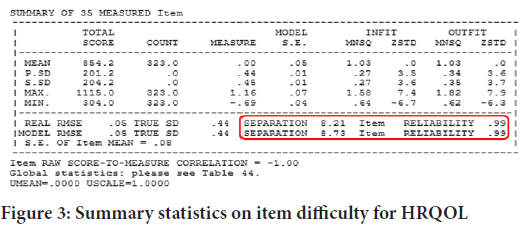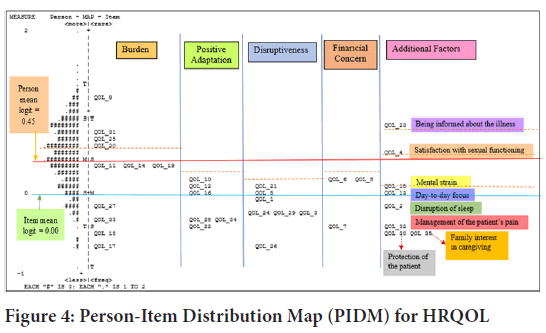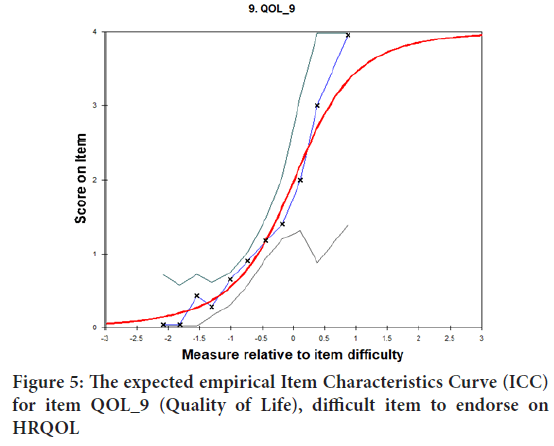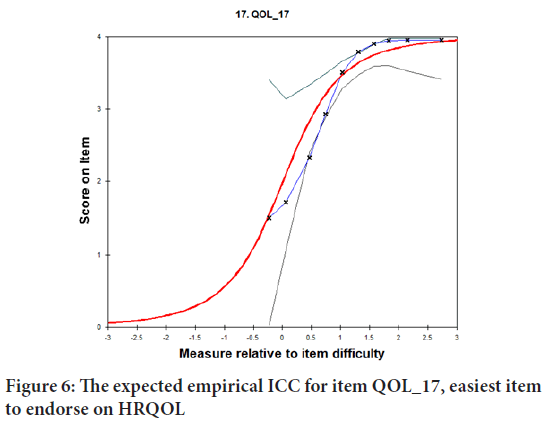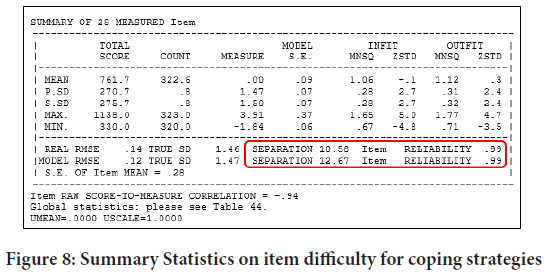Research Article - (2022) Volume 13, Issue 11
Association between Health-Related Quality of Life and Coping Strategies of Gastrointestinal Cancer Caregivers: A Rasch Analysis
Nur Afrina Ikhsan1, Zamalia Mahmud1 and Nik Nairan Abdullah2*Abstract
The number of Gastrointestinal (GI) cancer patients in Malaysia is rising. Caregivers need to perform their responsibilities as they spend most of their time providing care for the patient in their homes. To what extend does Health-Related Quality of Life (HRQOL) of GI caregivers relates to coping strategies of caregivers are unknown and yet to be investigated. This study investigates the caregivers’ response pattern towards HRQOL and coping strategies survey items across several domains and the association between HRQOL and coping strategies of the caregivers. This study used Rasch measurement model in the analysis of survey data gathered from 323 GI cancer caregivers from three public hospitals. Data were collected using HRQOL and Coping strategies instruments administered to the GI caregivers. It was found that four items (QOL_9, QOL_20, QOL_25 and QOL_31) under the Burden domain are among the most difficult to endorse by GI caregivers in the HRQOL items. Meanwhile, two items (COPE4 and COPE11) under the Substance Use domain in the coping strategies constructs are most difficult to endorse by GI cancer caregivers. This study also discovered that majority of caregivers who have issues with mental strain, disruptiveness, daily focus and sleep disruption applied positivity adaptation and use of emotional support as their coping strategies.
Keywords
Gastrointestinal cancer, Caregivers, Health-Related Quality of Life (HRQOL), Coping strategies, Rasch measurement model
Introduction
Gastrointestinal (GI) cancer is a group of cancer that influence the digestive system that involves stomach or gastric cancer, liver cancer, oesophageal cancer, bower or colorectal cancer, pancreat- ic cancer, anal cancer, bile duct cancer, Gastrointestinal carcin- oid tumor, small intestine cancer and gallbladder cancer (ACRF, 2017). One of GI cancer which is colorectal cancer has been one of the most common cancers for both genders in Malaysia. This type of cancer is being the number one cancer in men and the second in women following breast cancer (Azizah AM, et al., 2015).
There are rising numbers of cancer patients are being treated as outpatients due to the rising frequency of GI cancer (Abdullah NN, et al., 2019). Hence, the part of caregivers is getting more im- portant since they are the closest person to the patient. Accord- ing to Hunt GH, et al., 2016, caregivers of the cancer patients go through an average of 32.9 hours per week to take care of their loved one and 43 percent doing nursing jobs without any guid- ance.
There are rising numbers of cancer patients are being treated as outpatients due to the rising frequency of GI cancer (Abdullah NN, et al., 2019). Hence, the part of caregivers is getting more im- portant since they are the closest person to the patient. Accord- ing to Hunt GH, et al., 2016, caregivers of the cancer patients go through an average of 32.9 hours per week to take care of their loved one and 43 percent doing nursing jobs without any guid- ance.
Health-Related Quality of Life (HRQOL) of caregivers
According to Lim HA, et al., 2017, the caregiver’s culture was a noteworthy indicator of their QOL. The QOL of the Asian care- givers have been discovered to be lesser than the caregivers in European nations since the western nations have more reachable healthcare support system. The characteristics of the caregivers are actually linked with their HRQOL. Men caregivers frequent- ly have better health both physically and mentally (Gibbons C, et al., 2014). In addition, the age of the caregiver also affects their HRQOL. This is because the elder caregivers of patients with stroke or dementia were reported to have a potential living with chronic diseases compared to the young caregivers (Lim YM, et al., 2008; Carter JH, et al., 2010). The physical well-being of elder caregivers can be conceded by the demands of caregiving and psychological issues such as thoughts of loss and sorrow.
In a study by Lua PL, et al., 2013, they stated that the Quality of Life of the caregivers was evaluated by via Malay Caregiver Qual- ity of Life scale (MCQOL) and this is an adjustment of the English version of the Caregiver Quality of Life scale (Weitzner MA, et al., 1999). According to Abdullah NN, et al., 2019, this question- naire involves of 35 items in total. These items evaluate disturb- ance of sleep, sexual functioning satisfactions’, daily focus, mental strain, getting enough information regarding the illness, patient’s protection, managing of the patient’s pain and concern of family in caregiving. The QOL of the caregivers has 0.90 of reliability (Cronbach’s alpha) which means this instrument provide greater degree of consistency and stability. The Cronbach’s alpha for all domains was high that range from 0.78 to 0.84 where the value of Cronbach’s alpha for disruptiveness was 0.83, positive adaptation was 0.78 and burden was 0.84. However, the financial concern has the lowest Cronbach’s alpha value which is 0.43 as the items on insurance coverage did not utilize to all respondents. So, the item on insurance coverage was deleted and the Cronbach’s alpha in- creased to 0.73. The greatest score of the domains denoted a good HRQOL (Lua PL, et al., 2013).
Coping strategies of caregivers
The function of coping strategy is to resolve the issue or control the emotional reaction in the hectic circumstances (Penley JA, et al., 2002). However, coping strategies alone are inefficient for the caregiver’s stress (Folkman S, 2008). Coping strategies are appeared to be related to vari- ables like burden of the caregivers, involvement of caregiving, expressed reactions, community bolster, mental morbidity in the caregivers, Quality of Life (QOL) of the caregivers (Grover S and Chakrabarti S, 2015). Coping strategies was applied for handling with issues while the caregivers do not have sufficient time to provide care for patient with serious mental illness (Li J, et al., 2007). While in the study from García-Alberca JM, et al., 2012, it indicates that coping strategies were related to anxiety and depressed in caregivers of patient with Alzheimer’s Disease (AD). The caregivers who applied detachment coping strategies often have greatest degree of anx- iety and depression while caregivers who applied more attachment coping strategies have lesser degree of anxiety and depression. Thus, coping is the most significant indicator of mental distress on the caregivers.
A study from Yusoff N, et al., 2009, uses Brief Cope in order to evaluate a wide scope of coping behaviour of adults for all circumstance, illnesses and non-illnesses. There are 14 dimensions and two items for every dimension in their study. The items in their study were about self-distraction, active coping, denial, use of substance, use of emotional support, use of instru- mental support, behavioural disengagement, venting of emotion, positive reinterpretation, planning, humour, acceptance, religion and self-blame. Moreover, the Malay Version of Brief Cope Scale was tested on the sample of female with breast cancer. The reliability of Malay Version of Brief Cope Scale was ranged from 0.51 to 0.99 which is reliable and valid instrument that can be used for the population of Malaysia due to its acceptable inter- nal consistency.
Rasch measurement model
Rasch models are suitable for evaluating and measuring psychological variables such as capabilities, attitudes, and personality characters where the goal is to acquire an accurate and objective measurement. Rasch model would be a helpful instrument for calibration of items that provides a con- dition for successful measurement (Ferrari PA and Salini S, 2011). Rasch measurement model is a model that is established two parameters which are the ability of person who answered the questions in the instruments and the difficulty of every single item (Rasch G, 1980). Each person is categorized based on ability and items are categorized based on difficulty. Both of the parameters can be evaluated in logits or log odd value.
Rasch polytomous or also known as rating scale model ascertains the rela- tive difficulty of every item from the smallest to the greatest levels that the instrument can record (Mahmud Z and Porter AL, 2015). Items in this study consists of five categories of response for Health-Related Quality of Life (HRQOL) such as from 0=Not at all to 4=Very much. While for coping strategies consists of four categories of response such as from 1=I haven’t been doing this at all to 4=I’ve been doing this a lot. I’ve been doing this a lot. The Rasch rating scale model that developed by Andrich D, 1978:

Where; βn=Person ability, δi=Item difficulty to endorse, τk=Response threshold estimated for the m+1 rating category and m=Maximum score and identical for all items.
Methodology
Study design
This is a secondary data study. Data was acquired from a survey study on HRQOL and coping strategies of the GI cancer caregivers as provided by the principal researcher at the Department of Population Health and Pre- ventive Medicine (PHPM), Faculty of Medicine, UiTM Shah Alam. The data was gathered from a survey on 323 respondents who were caregivers of the GI cancer patients. In the survey, the caregivers were asked to provide feedback about their Health-Related Quality of Life and coping strategies based on the HRQOL for caregiver and Brief Cope scales instruments.
Data analysis procedure
This study was essentially focusing on data collected from Part A (Demo- graphic), Part D and Part F (Figure 1). Using Winsteps 3.90.2 software, logit scales from the HRQOL and Brief Cope constructs were distributed in a Wright map (also called as Person-Item Distribution Map (PIDM) and Item Characteristics Curve (ICC). Figure 1 describes the methodological process and data analysis of the study. The measurement includes sum- mary statistics based on the logit scales.

Figure 1: Methodological process and data analysis
Results
Reliability of HRQOL items
Figure 2 shows the person reliability index for HRQOL items at 0.85 is good and consistent. The mean square infit and outfit for persons are 1.04 and 1.03, respectively. Both mean standardized infit and outfit for persons are 0.0. The cut-off value of primary standard deviation for mean square infit and outfit for person is 2.0. This is shown by the person mean square infit and outfit at 0.39 and 0.43, respectively. All these infit and outfit logit measurement shows an overall acceptable fit of data to the Rasch model. The person separation index is 2.41, an indication of two levels of person responses. Person separation indices of two are considered as fairly good (Duncan PW, et al., 2003).
Figure 2: Summary statistics on person ability for Health-Related Quality of Life (HRQOL)
Figure 3 shows an extremely high item reliability index at 0.99. If the data fits the model well, the meansquare infit and outfit for item will be close to 1.00. This concurs with the mean square infit and outfit for items at 1.03 logit and the mean standardized infit and outfit at 0.0 logit. If the cut-off value of primary standard deviation for mean square infit and outfit for items is 2.0, then data shows an overall acceptable fit. This is indeed shown in the primary standard deviation of the mean square infit and outfit for items at 0.27 and 0.34 logit, respectively. Finally, the item separation index is 8.21, an indication that items are separated into eight levels of difficulty (Linacre JM, 2012).
Figure 3: Summary statistics on item difficulty for HRQOL
Wright map for HRQOL caregivers
The illustration of the persons and items distribution for HRQOL of GI cancer caregivers on a common logit scale is shown in Figure 4. The pos- ition of persons with high ability to endorse is located above person mean logit scale at 0.45 whereas the positions of persons with low ability are lo- cated below the mean logit scale.
Figure 4: Person-Item Distribution Map (PIDM) for HRQOL
In Figure 4, about 60% who responded to burden domain items QOL_9 “I fear my loved one will die”, QOL_31 “It upsets me to see my loved one deteriorate”, QOL_25 “I fear the adverse effects of treatment on my loved one” and QOL_20 “I have difficulty dealing with my loved one’s changing eating habits” could hardly endorse these items which are located above the person mean logit. On the other hand, 98% could easily endorse items QOL_17 “I do not feel guilty” and QOL_18 “I do not feel frustrated”.
For positive adaptation, disruptiveness and financial concern domains, be- tween 74% and 78% of the respondents could easily endorse items which are located below the person mean logit scale. The easiest item to endorse for positive adaptation is QOL_22 “I have developed a closer relationship with my loved ones”; for disruptiveness is QOL_26, for “The responsibility I have for my loved one’s care at home is overwhelming” and for financial concern is QOL 7 “I am concerned about our insurance coverage”.
Item Characteristic Curve (ICC) for HRQOL
Figure 5shows the expected empirical ICC for item logit measure QOL_9 which states “I fear my loved one will die” indicates a fairly difficult item to endorse among the HRQOL constructs. About two third of the points lies below 50% on the expected ogive curve and within 95% confidence interval which indicates majority of caregivers feared that their loved ones will die.
Figure 5: The expected empirical Item Characteristics Curve (ICC) for item QOL_9 (Quality of Life), difficult item to endorse on HRQOL
On the other hand, Figure 6shows the expected empirical ICC for item logit measure for QOL_17 which states “I feel guilty”. This item is the eas- iest to endorse by GI caregivers among other HRQOL constructs. About two third of the points lies above 50% on the expected ogive curve and within 95% confidence interval which indicates majority of caregivers do not feel burden and guilty while caring for their loved ones.
Figure 6: The expected empirical ICC for item QOL_17, easiest item to endorse on HRQOL
Reliability for coping strategies
Figure 7 shows the person reliability index for coping strategies is highly reliable and consistent at 0.87 logit. Higher person reliability indicates a wide range of responses provided by the caregivers. The mean square infit and outfit for persons are 1.00 and 1.10, respectively. The expected value for mean standardized infit and outfit are 0.0 and the mean standardized infit and outfit for persons are -0.2 and 0.1, respectively. All these infit and outfit logit measurement indicates that the data fits the Rasch model well. The standard deviation infit and outfit reflects an overall fit for persons at a 2.0 cut-off value. Here the primary standard deviation for person infit and outfit is 0.53 and 1.16, respectively. This also indicates that the data is within the acceptable range of Rasch model. Figure 7 also shows that the person separation index is 2.61 suggesting an approximately three levels of caregivers coping strategies.
Figure 7: Summary Statistics on person ability for coping strategies
Figure 8 indicates a high item reliability index at 0.99 logit. This indicates items are replicable for evaluating similar traits. The mean square infit and outfit for item mean squares are 1.06 and 1.12, respectively. The mean stan- dardized infit and outfit for items are -0.1 and 0.3, respectively which is within the acceptable range of Rasch measurement. The standardized infit standard deviation for item is 0.28 and the item separation index shows that the items were separated into 12 levels of difficulty.
Figure 8: Summary Statistics on item difficulty for coping strategies
Person-Item Distribution Map (PIDM) for coping strategies
Figure 9 illustrates the persons and items distribution map for coping strat- egies of GI cancer caregivers on a common logit scale.
Figure 9: Person-Item Distribution Map (PIDM) for coping strategies
In Figure 9, the ability of persons is normally distributed within ± 2.0 stan- dard deviation from the mean person logit scale. The coping items are cat- egorized across 14 sub-domains according to the type of coping strategies. Most caregivers stated substance use which are COPE11 “I’ve been using alcohol or other drugs to help me get through it” and COPE 4 “I’ve been using alcohol or other drugs to make myself better” are difficult to endorse. For the acceptance domain, about 98% of the caregivers can easily endorse items COPE 20 “I’ve been accepting the reality of the fact that it has hap- pened” and COPE 24 “I’ve been trying to live with it”. The caregivers have mainly accepted the reality of their situation and have been trying to live with the caregiving tasks.
Item Characteristic Curve (ICC) for coping strategies
Figure 10 illustrates the expected empirical ICC the corresponding item logit measure for COPE11 “I’ve been using alcohol or other drugs to help me get through it” is difficult to endorse by caregivers. About all points lies below 50% on the expected curve and within 95% confidence interval which shows that caregivers had been using alcohol or drugs to help them get through the caregiving job.
Figure 10: The expected empirical ICC and frequency table for COPE11
In contrast, the expected empirical ICC and frequency table for COPE24 “I’ve been trying to live with it” is shown in Figure 11. This item is easily to endorse by GI caregivers on coping strategies. Around two third of the points lies above 50% on the expected ogive curve and within 95% confi- dence interval which explains the majority of caregivers have been trying to live with the caregiving job.
Figure 11: The expected empirical ICC and frequency table for COPE24
Person-Item Distribution Map (PIDM) between HRQOL and coping strategies of GI cancer caregivers
Figure 12illustrates the comparison of Person-Item Distribution Map (PIDM) between HRQOL and coping strategies of GI cancer caregivers items.
Figure 12: Person-Item Distribution Map (PIDM) between HRQOL and coping strategies of GI cancer caregivers
The HRQOL and Coping Strategies items are plotted side by side on the interval logit scale ranging from -0.93 to 1.33 logits. The description shall focus on the mapping of few items in HRQOL and Coping Strategies. For item QOL_9 “I fear my loved one will die”, majority found this to be easily endorsed. In spite of this, majority find it difficult to endorse COPE11 “I’ve been using alcohol or other drugs to help me get through it” and COPE4 “I’ve been using alcohol or other drugs to make myself feel better”. These caregivers feared about losing their loved ones but not to the extent of tak- ing alcohol and drugs to make them feel better. Mapping of item QOL_9 with COPE 24 “I’ve been trying to live with it” seems acceptable as well. Even though they fear of losing their loved ones, they have been trying to live with the situation.
For items which are located below the item mean logit, about 98% of re- spondents reported three items in positive adaptation (QOL_10 “I have more of a positive outlook on life since my loved one’s illness”, QOL_12 “My sense of spirituality has increased” and QOL_16 “I get support from my friends and neighbours”), an item in mental strain (QOL_15 “I feel under increased mental strain), four items in disruptiveness (QOL_1 “It bothers me that my daily routine is altered”, QOL_5 “It is a challenge to maintain my outside interest”, QOL_21 “I have difficulty dealing with my loves one’s changing eating habits”, QOL_24 “It bothers me that I need to be available to chauffeur my loved one to appointments), an item in day- to-day focus (QOL_13 “It bothers me, limiting my focus day-to-day”) and an item in disruption of sleep (QOL_2 “My sleep is restful”).
Upon mapping these HRQOL items with positive reinterpretation (COPE12 “I’ve been trying to see it in a different light to make it seem more positive and COPE17 “I’ve been looking for something good in what is happening”) and an item in use of emotional support (COPE15 “I’ve been getting comfort and understanding from someone”), it can be gathered that caregivers were trying to adapt with positivity and require emotional support as their coping strategies even though they have issues with mental strain, disruptiveness, daily focus and sleep disruption.
Discussion and Conclusion
In examining HRQOL, respondents have high burden but maintain the positivity in adapting to the caregiving situation. They are concerned with maintaining financial stability and less disruptiveness. Meanwhile, respondents tend to use acceptance as their coping strategies to maintain good HRQOL. They have been accepting the reality and been trying to live with the caregiving task as they already adapted with the caregiving job for a long period. Hence, this study is able to discover the caregiver’s Health-Related Quality of Life (HRQOL) and their difficulties in per- forming their caregiving tasks while demonstrating their strategies in cop- ing with the caregiving situation.
Declarations
Availability of data and material
The data that support the findings of this study are available from the cor- responding author Abdullah NN upon reasonable request.
Code availability
This study used Winsteps software to analyze the data.
Authors’ contribution
NNA collected the data for her study as citied in the article of Abdullah NN, 2019. Meanwhile, NAI and ZM drafted and designed the study. NAI wrote the manuscript, analyze the data and interpreted the findings. All authors approved the final version of the manuscript.
Ethics approval
This study was performed in accordance with the ethical standards as laid down in the 1964 Declaration of Helsinki and its later amendments or comparable ethical standards. This study was approved by the Ethics committee of the National University of Malaysia and the Medical Research and Ethics Committee, Ministry of Health Malaysia.
Consent to participate
Informed consent was obtained from all individual participants included in the study.
Consent publication
The participants have consented to the submission of the study to the jour- nal.
References
- ACRF. Gastrointestinal cancers: Symptoms, treatments and research. Australian Cancer Research Foundation. 2017.
- Azizah AM, nor Saleha IT, noor Hashimah A, Asmah ZA, Mastulu W. Malaysian national cancer registry report 2007-2011. National Cancer Institute. 2015: 228.
- Abdullah NN, Idris IB, Shamsuddin K, Abdullah NM. Health-Related Quality of Life (HRQOL) of gastrointestinal cancer caregivers: The impact of caregiving. Asian Pac J Cancer Prev. 2019; 20(4): 1191.
[Crossref] [Google Scholar] [Pubmed]
- Hunt GH, Longacre ML, Kent EE, Weber-Raley L. Cancer caregiving in the US: An intense, episodic, and challenging care experience. National Alliance for Caregiving. 2016; 34.
- Lim HA, Tan JY, Chua J, Yoong RK, Lim SE, Kua EH, et al. Quality of life of family caregivers of cancer patients in Singapore and globally. Singapore Med J. 2017; 58(5): 258.
[Crossref] [Google Scholar] [Pubmed]
- Gibbons C, Creese J, Tran M, Brazil K, Chambers L, Weaver B, et al. The psychological and health consequences of caring for a spouse with dementia: A critical comparison of husbands and wives. J Women Aging. 2014; 26(1): 3-21.
[Crossref] [Google Scholar] [Pubmed]
- Lim YM, Son GR, Song JA, Beattie E. Factors affecting burden of family caregivers of community-dwelling ambulatory elders with dementia in Korea. Arch Psychiatr Nurs. 2008; 22(4): 226-234.
[Crossref] [Google Scholar] [Pubmed]
- Carter JH, Lyons KS, Stewart BJ, Archbold PG, Scobee R. Does age make a difference in caregiver strain? Comparison of young versus older caregivers in early‐stage Parkinson's disease. Mov Disord. 2010; 25(6): 724-730.
[Crossref] [Google Scholar] [Pubmed]
- Lua PL, Norhayati M, AR AK. HRQoL profile and psychometric properties assessment of caregiver quality of life instrument among HIV/AIDS family caregivers in Terengganu. Malaysian Journal of Psychiatry. 2013; 22(1).
- Weitzner MA, Jacobsen PB, Wagner H, Friedland J, Cox C. The Caregiver Quality of Life Index-Cancer (CQOLC) scale: Development and validation of an instrument to measure quality of life of the family caregiver of patients with cancer. Qual Life Res. 1999; 8(1): 55-63.
[Crossref] [Google Scholar] [Pubmed]
- Penley JA, Tomaka J, Wiebe JS. The association of coping to physical and psychological health outcomes: A meta-analytic review. J Behav Med. 2002; 25(6): 551-603.
[Crossref] [Google Scholar] [Pubmed]
- Folkman S. The case for positive emotions in the stress process. Anxiety Stress Coping. 2008; 21(1): 3-14.
[Crossref] [Google Scholar] [Pubmed]
- Grover S, Chakrabarti S. Coping among the caregivers of patients with schizophrenia. Ind Psychiatry J. 2015; 24(1): 5.
[Crossref] [Google Scholar] [Pubmed]
- Li J, Lambert CE, Lambert VA. Predictors of family caregivers' burden and quality of life when providing care for a family member with schizophrenia in the People's Republic of China. Nurs Health Sci. 2007; 9(3): 192-198.
[Crossref] [Google Scholar] [Pubmed]
- García-Alberca JM, Cruz B, Lara JP, Garrido V, Lara A, Gris E. Anxiety and depression are associated with coping strategies in caregivers of Alzheimer's disease patients: Results from the MALAGA-AD study. Int Psychogeriatr. 2012; 24(8): 1325-1334.
[Crossref] [Google Scholar] [Pubmed]
- Yusoff N, Low WY, Yip CH. Reliability and validity of the Malay version of Brief COPE Scale: A study on Malaysian women treated with adjuvant chemotherapy for breast cancer. Malaysian Journal of Psychiatry. 2009; 18(1).
- Ferrari PA, Salini S. Complementary use of Rasch models and nonlinear principal components analysis in the assessment of the opinion of Europeans about utilities. J Classif. 2011; 28(1): 53-69.
- Rasch G. Weblogs models for some intelligence and Student tests. The University of Chicago Press. 1980.
- Mahmud Z, Porter AL. Using Rasch analysis to explore what students learn about probability concept. Indonesian Mathematical Society Journal on Mathematics Education. 2015; 6(1): 1-10.
- Andrich D. A rating formulation for ordered response categories. Psychometrika. 1978; 43(4): 561-573.
- Duncan PW, Bode RK, Lai SM, Perera S, Glycine Antagonist in Neuroprotection Americas Investigators. Rasch analysis of a new stroke-specific outcome scale: The Stroke Impact Scale. Arch Phys Med Rehabil. 2003; 84(7): 950-963.
[Crossref] [Google Scholar] [Pubmed]
- Linacre JM. Winsteps® Rasch measurement computer program user’s guide. Beaverton, Oregon: Winsteps. 2012.
Author Info
Nur Afrina Ikhsan1, Zamalia Mahmud1 and Nik Nairan Abdullah2*2Department of Population Health and Preventive Medicine (PHPM), Universiti Teknologi MARA (UiTM), Selangor, Malaysia
Citation: Ikhsan NA: Association between Health-Related Quality of Life and Coping Strategies of Gastrointestinal Cancer Caregivers: A Rasch Analysis
Received: 20-Oct-2022 Accepted: 03-Nov-2022 Published: 10-Nov-2022, DOI: 10.31858/0975-8453.13.11.727-732
Copyright: This is an open access article distributed under the terms of the Creative Commons Attribution License, which permits unrestricted use, distribution, and reproduction in any medium, provided the original work is properly cited.
ARTICLE TOOLS
- Dental Development between Assisted Reproductive Therapy (Art) and Natural Conceived Children: A Comparative Pilot Study Norzaiti Mohd Kenali, Naimah Hasanah Mohd Fathil, Norbasyirah Bohari, Ahmad Faisal Ismail, Roszaman Ramli SRP. 2020; 11(1): 01-06 » doi: 10.5530/srp.2020.1.01
- Psychometric properties of the World Health Organization Quality of life instrument, short form: Validity in the Vietnamese healthcare context Trung Quang Vo*, Bao Tran Thuy Tran, Ngan Thuy Nguyen, Tram ThiHuyen Nguyen, Thuy Phan Chung Tran SRP. 2020; 11(1): 14-22 » doi: 10.5530/srp.2019.1.3
- A Review of Pharmacoeconomics: the key to “Healthcare for All” Hasamnis AA, Patil SS, Shaik Imam, Narendiran K SRP. 2019; 10(1): s40-s42 » doi: 10.5530/srp.2019.1s.21
- Deuterium Depleted Water as an Adjuvant in Treatment of Cancer Anton Syroeshkin, Olga Levitskaya, Elena Uspenskaya, Tatiana Pleteneva, Daria Romaykina, Daria Ermakova SRP. 2019; 10(1): 112-117 » doi: 10.5530/srp.2019.1.19
- Dental Development between Assisted Reproductive Therapy (Art) and Natural Conceived Children: A Comparative Pilot Study Norzaiti Mohd Kenali, Naimah Hasanah Mohd Fathil, Norbasyirah Bohari, Ahmad Faisal Ismail, Roszaman Ramli SRP. 2020; 11(1): 01-06 » doi: 10.5530/srp.2020.1.01
- Manilkara zapota (L.) Royen Fruit Peel: A Phytochemical and Pharmacological Review Karle Pravin P, Dhawale Shashikant C SRP. 2019; 10(1): 11-14 » doi: 0.5530/srp.2019.1.2
- Pharmacognostic and Phytopharmacological Overview on Bombax ceiba Pankaj Haribhau Chaudhary, Mukund Ganeshrao Tawar SRP. 2019; 10(1): 20-25 » doi: 10.5530/srp.2019.1.4
- A Review of Pharmacoeconomics: the key to “Healthcare for All” Hasamnis AA, Patil SS, Shaik Imam, Narendiran K SRP. 2019; 10(1): s40-s42 » doi: 10.5530/srp.2019.1s.21
- A Prospective Review on Phyto-Pharmacological Aspects of Andrographis paniculata Govindraj Akilandeswari, Arumugam Vijaya Anand, Palanisamy Sampathkumar, Puthamohan Vinayaga Moorthi, Basavaraju Preethi SRP. 2019; 10(1): 15-19 » doi: 10.5530/srp.2019.1.3








